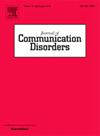有晚说话史的英语学龄儿童的停顿模式:频繁的停顿和长时间的反应延迟
IF 2.1
3区 医学
Q2 AUDIOLOGY & SPEECH-LANGUAGE PATHOLOGY
引用次数: 0
摘要
本研究探讨了沉默停顿模式,它们与填充停顿的相互作用,以及五岁儿童的反应延迟,这些儿童在与成年人的对话中被认为是晚说话者。方法我们分析了来自CHILDES临床英语Ellis Weismer语料库的73例儿童-成人对话(36例有晚说话史,37例发育正常),涵盖了3个时间阶段。使用Praat,我们识别并分类了沉默停顿(>;250毫秒)的持续时间和位置,并在三个层次上对它们进行注释:无声暂停类别,填充暂停附近的暂停和响应延迟。我们采用混合效应模型来检验群体和性别在停顿时间、频率和位置上的差异,以及它们与对话阶段的填充停顿和反应延迟的关系。结果基于持续时间的分析显示,有晚说话史的儿童比正常发育的儿童产生更长、更频繁的沉默停顿,特别是在500-1000毫秒之间,而男性的短停顿较少。基于位置的分析显示,有晚说话史的儿童表现出更多的话语开始停顿和短语内停顿,而男性表现出更短的话语开始停顿。虽然正常发育的儿童在对话阶段表现出较少的停顿,但有晚说话历史的儿童保持一致的模式。两组孩子都更喜欢用“嗯”而不是“嗯”,尽管有晚说话历史的孩子更依赖于“嗯”和沉默停顿的组合。反应延迟分析表明,这些儿童的反应延迟更长。结论:有晚说话史的学龄儿童在暂停模式上表现出持续的差异,这突出了延长支持的必要性。这些发现为临床实践中考虑会话时机的有针对性干预措施的发展提供了信息。本文章由计算机程序翻译,如有差异,请以英文原文为准。
Pausing patterns in English school-age children with a history of late talking: Frequent pauses and prolonged response delays
Introduction
This study explored silent pause patterns, their interaction with filled pauses, and response delays in five-year-old children who were previously identified as late talkers in their conversations with adults.
Methods
We analyzed 73 child-adult conversations (36 with a late-talking history, 37 typically developing) from the CHILDES Clinical English Ellis Weismer Corpus at age five across three temporal stages. Using Praat, we identified and classified silent pauses (> 250 ms) by duration and position and annotated them across three tiers: silent pause categories, pauses near filled pauses, and response delays. We employed mixed-effects models to examine group and gender differences in pause duration, frequency, and position, alongside their relationship with filled pauses, and response delays across conversational stages.
Results
Duration-based analyses revealed children with a history of late talking produced longer and more frequent silent pauses than typically developing children, particularly at 500–1000 ms, with males showing fewer short pauses. Position-based analyses showed children with a history of late talking exhibited more utterance-onset and within-phrase pauses, whilst males demonstrated shorter utterance onset pauses. Whilst typically developing children demonstrated decreased pausing across conversational stages, children with a late-talking history maintained consistent patterns. Both groups preferred ‘um’ over ‘uh’, though children with a late-talking history showed greater reliance on ‘um’-silent pause combinations. Response delay analyses indicated these children had longer delays.
Conclusions
School-age children with a history of late talking demonstrate persistent differences in pausing patterns, highlighting the need for extended support. These findings inform the development of targeted interventions considering conversational timing in clinical practice.
求助全文
通过发布文献求助,成功后即可免费获取论文全文。
去求助
来源期刊

Journal of Communication Disorders
AUDIOLOGY & SPEECH-LANGUAGE PATHOLOGY-REHABILITATION
CiteScore
3.30
自引率
5.90%
发文量
71
审稿时长
>12 weeks
期刊介绍:
The Journal of Communication Disorders publishes original articles on topics related to disorders of speech, language and hearing. Authors are encouraged to submit reports of experimental or descriptive investigations (research articles), review articles, tutorials or discussion papers, or letters to the editor ("short communications"). Please note that we do not accept case studies unless they conform to the principles of single-subject experimental design. Special issues are published periodically on timely and clinically relevant topics.
 求助内容:
求助内容: 应助结果提醒方式:
应助结果提醒方式:


